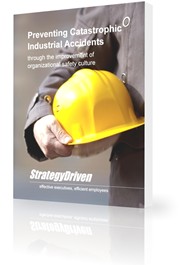Corporate Cultures – Individual Initiated, Documented Processes Controlled Environment
The Individual Initiated, Knowledge and Skills Controlled Environment represents a culture that seeks to actively harness and channel worker creativity. These organizations foster creativity among workers in a controlled manner that enables the company achieve its mission objectives while making room for a degree of experimentation. This culture set benefits from some added creativity and consistency but does stifle full-fledged creativity in order to minimize risks.
Hi there! Gain access to this article with a StrategyDriven Insights Library – Total Access subscription or buy access to the article itself.
| Subscribe to the StrategyDriven Insights Library
Sign-up now for your StrategyDriven Insights Library – Total Access subscription for as low as $15 / month (paid annually). Not sure? Click here to learn more. |
Buy the Article
Don’t need a subscription? Buy access to Corporate Cultures – Individual Initiated, Documented Processes Controlled Environment for just $2! |

 Michael Feuer co-founded OfficeMax in 1988 starting with one store and $20,000 of his own money, a partner, and a small group of investors. As CEO, he grew it to more than 1,000 stores worldwide with annual sales topping $5 billion. He is also CEO of Max-Ventures, a venture capital and retail consulting firm, and founder and CEO of Max-Wellness, a comprehensive health and wellness retail chain that launched in 2010. After opening initial laboratory test stores in Florida and Ohio, a national roll-out is now underway. To read Michael Feuer’s complete biography,
Michael Feuer co-founded OfficeMax in 1988 starting with one store and $20,000 of his own money, a partner, and a small group of investors. As CEO, he grew it to more than 1,000 stores worldwide with annual sales topping $5 billion. He is also CEO of Max-Ventures, a venture capital and retail consulting firm, and founder and CEO of Max-Wellness, a comprehensive health and wellness retail chain that launched in 2010. After opening initial laboratory test stores in Florida and Ohio, a national roll-out is now underway. To read Michael Feuer’s complete biography,  Hank Moore has advised 5,000+ client organizations worldwide (including 100 of the Fortune 500, public sector agencies, small businesses and non-profit organizations). He has advised two U.S. Presidents and spoke at five Economic Summits. He guides companies through growth strategies, visioning, strategic planning, executive leadership development, Futurism and Big Picture issues which profoundly affect the business climate. He conducts company evaluations, creates the big ideas and anchors the enterprise to its next tier. The Business Tree™ is his trademarked approach to growing, strengthening and evolving business, while mastering change. To read Hank’s complete biography,
Hank Moore has advised 5,000+ client organizations worldwide (including 100 of the Fortune 500, public sector agencies, small businesses and non-profit organizations). He has advised two U.S. Presidents and spoke at five Economic Summits. He guides companies through growth strategies, visioning, strategic planning, executive leadership development, Futurism and Big Picture issues which profoundly affect the business climate. He conducts company evaluations, creates the big ideas and anchors the enterprise to its next tier. The Business Tree™ is his trademarked approach to growing, strengthening and evolving business, while mastering change. To read Hank’s complete biography,  Organization members share a collective values system reflected in managerial decisions, individual behaviors, and codified within operating procedures. These values are shaped by both individual beliefs and collective experiences. Taken together, these values form the corporation’s culture.
Organization members share a collective values system reflected in managerial decisions, individual behaviors, and codified within operating procedures. These values are shaped by both individual beliefs and collective experiences. Taken together, these values form the corporation’s culture.